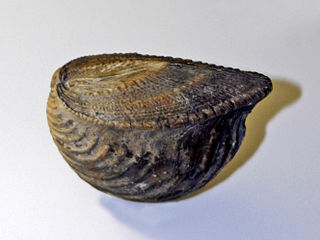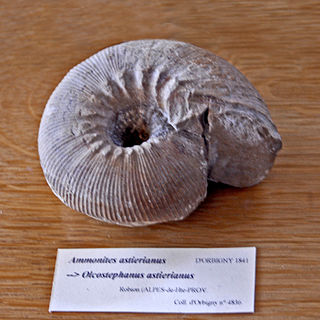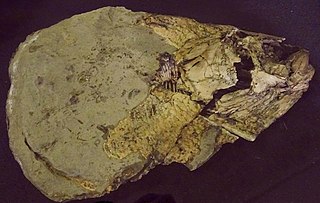Related Research Articles

Acanthoceras is an extinct cephalopod genus belonging to the subclass Ammonoidea and family Acanthoceratidae that lived from the Albian to early Coniacian stages of the Cretaceous.
Kamerunoceras is an extinct cephalopod genus belonging to the ammonite family Acanthoceratidae, found in Upper Cretaceous formations of Africa, Europe and North and South America.
Ankinatsytes is an extinct genus of cephalopod belonging to the Ammonite subclass. The ammonite is from the Late Cretaceous of Colombia and Venezuela.
Benueites is an extinct ammonoid cephalopod genus from the Late Cretaceous (Turonian), named by Revement, 1954, included in the family Acanthoceratidae, superfamily Acanthoceratoidea.

Anomia is a genus of saltwater clams, marine bivalve mollusks in the family Anomiidae. They are commonly known as jingle shells because when a handful of them are shaken they make a jingling sound, though some are also known as saddle oysters.
Neoptychites is an extinct ammonoid cephalopod genus from the Turonian stage of the Upper Cretaceous, with a worldwide distribution.
Morrowites, named by Cobban and Hook, 1983, is a moderate to large-sized ammonite with quadrangular to depressed whorls, broadly rounded to depressed venter, low ribs, umbilical and inner and outer ventrolateral tubercles and smooth early whorls except for occasional ribs along weak constrictions. The suture is moderately simple and has an unusually broad bifid first lateral lobe. It is so far restricted to the Lower Turonian stage, in the mid Cretaceous.

Mammites is a Late Cretaceous ammonite genus included in the acanthoceratoidean family, Acanthoceratidae, and the type genus for the subfamily Mammitinae. Mammites was named by Laube and Bruder in 1887.
Coilopoceras is a compressed, involute, lenticular ammonitid from the Cretaceous, with a narrow venter and raggedy ammonitic suture; type of the Coilopoceratidae, a family in the Acanthoceratoidea of the suborder Ammonitina.
Hoplitoides is an ammonite from the Upper Cretaceous, Turonian belonging to the Coilopoceratidae, a family in the Acanthoceratoidea. Hoplitoides have early whorls which are grooved, then flat, and finally narrowly rounded venters; early stages with umbilical tubercles and space ribs, later stages becoming smooth. The suture is similar to that of Coilopoceras but less extreme. Hoplitoides has an established distribution which is widespread, from western North America, northwestern Africa and northern South America.

Fagesia is a small, subglobular ammonite belonging to the vascoceratid family of the Acanthocerataceae that lived during the Turonian stage of the Late Cretaceous, 92–88 Ma ago.

Neocomites is a genus of ammonite from the Lower Cretaceous, Berriasian to Hauterivian, and type genus for the Neocomitidae.

Trigonia is an extinct genus of saltwater clams, fossil marine bivalve mollusk in the family Trigoniidae. The fossil range of the genus spans the Paleozoic, Mesozoic and Paleocene of the Cenozoic, from 298 to 56 Ma.

Vascoceras is an extinct genus of Cretaceous ammonites included in the family Vascoceratidae. These fast-moving nektonic carnivores lived in the Cretaceous period from the late Cenomanian to the early Turonian. The type species of the genus is Vascoceras gamai from Portugal.

Olcostephanus is an extinct ammonoid cephalopod genus belonging to the family Olcostephanidae. These fast-moving nektonic carnivores lived during the Cretaceous, from the upper Valanginian to the lower Hauterivian age.
Codazziceras is an early Late Cretaceous ammonite from the Late Cretaceous of Colombia, distinguished from Lyelliceras (Lyelliceratidae) from which it is based and added to the Euomphaloceratinae (Acanthoceratidae). The type species is Codazziceras scheibei and another described species is C. ospinae. Fossils of Codazziceras have been found in the La Frontera Formation of Huila, Cundinamarca and Boyacá, and in the Loma Gorda Formation of Aipe, Huila.

The La Frontera Formation (Spanish: Formación La Frontera, K2F, Ksf) is a geological formation, part of the Villeta Group, of the Altiplano Cundiboyacense and neighbouring areas of the Eastern Ranges of the Colombian Andes. The sequence of limestones and lydites dates to the Late Cretaceous period; Turonian epoch and has a maximum thickness of 206 metres (676 ft).

The Hondita Formation is a fossiliferous geological formation of the Upper Magdalena Valley (VSM) and surrounding Central and Eastern Ranges of the Colombian Andes, extending from Cundinamarca in the north to Huila and easternmost Tolima in the south. The lowermost unit of the Güagüaquí Group, a sequence of sandy limestones and shales, dates to the Late Cretaceous period; Turonian epoch, and has a maximum thickness of 90 metres (300 ft).

Bachea is an extinct genus of ray-finned fish that lived during the Late Cretaceous in what is now central Colombia, South America. The type species is Bachea huilensis, described in 1997 by María Páramo from the Turonian of Huila, Colombia.
References
- 1 2 "Paleobiology Database - Wrightoceras" . Retrieved 17 December 2021.
- ↑ Sepkoski, Jack (2002). "Sepkoski's Online Genus Database" . Retrieved 2014-05-28.
- ↑ Patarroyo, 2016, p.41
Bibliography
- Patarroyo, Pedro (2016), "Amonoideos y otros macrofósiles del lectoestratotipo de la Formación la Frontera, Turoniano inferior - medio (Cretácico Superior) en San Francisco, Cundinamarca (Colombia)" (PDF), Boletín de Geología, Universidad Industrial de Santander, 38: 41–54, retrieved 2017-04-04